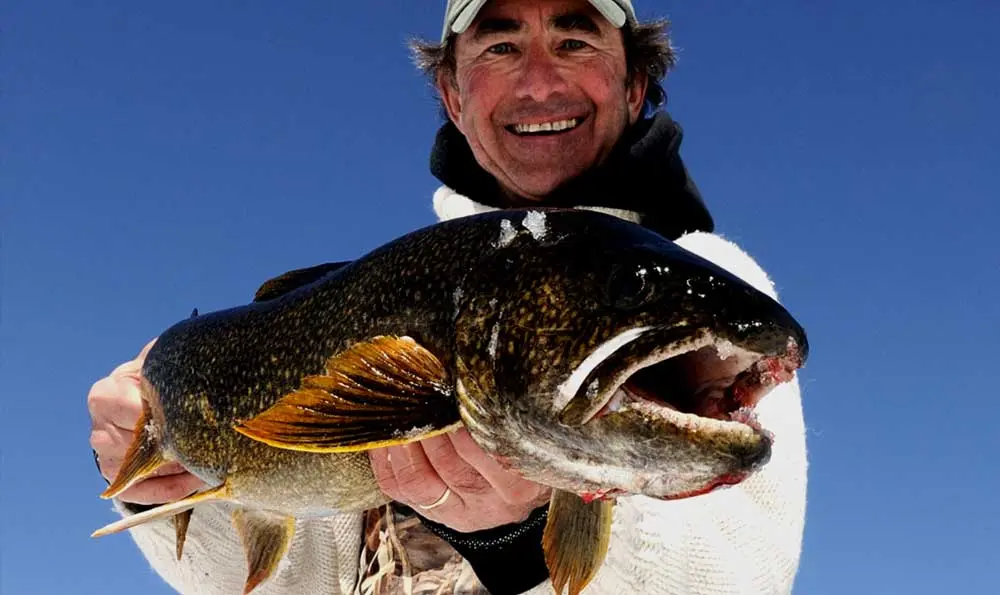Ice fishing in Ontario made easy
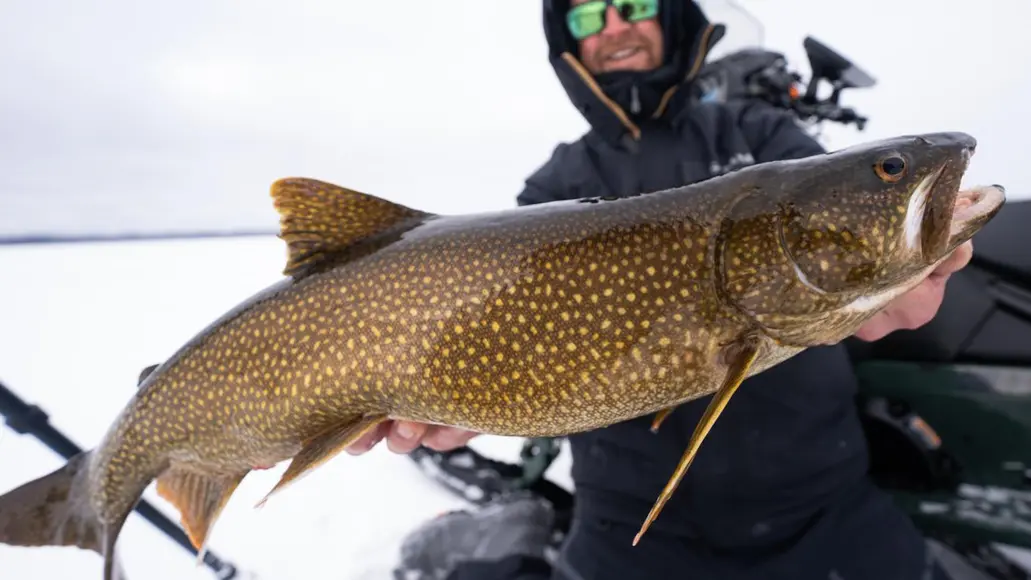
Atikokan | Browns Clearwater West Lodge
With heated huts and bungalows, pre-drilled ice fishing holes, transportation to your hut, and more facilities, services, and instruction, fishing outfitters in Ontario make the experience of ice fishing easy, fun and warm.
In addition, find out what you need to prepare and know before setting out on an ice fishing excursion in Ontario.
Ice fishing lodges and hut rentals
Here are six fishing operators and lodges that will make it easy for you to get started. You can also connect with local fishing guides across Ontario to help make your ice fishing adventure a smooth one.
Browns Clearwater West Lodge
Being the only lodge on Clearwater West Lake, the fishing at Browns is exceptional. In fact, Browns can brag of having two world record ice fishing lake trout catches.
Located in the Atikokan area in Sunset Country, this lodge and campground is open year-round. Upon arrive, travel across the lake to an outpost cabin or stay in one of two units at the main lodge. Keep an eye out for special winter events for ice fishing, including a Women’s Ice Fishing Weekend on the Browns Clearwater Facebook page.
Locations: Clearwater West Lake, Atikokan
Crawfords Camp
While famous for its open water fishing, Lake of the Woods is also renowned for its ice. Experience some of the best trout, walleye, musky and northern ice fishing at Crawfords Camp.
This family-run camp has operated since 1978 and features fully equipped, heated and winterized cottages (two are wheelchair assessable). All 12 cabins have full bathrooms and various amenities. Bring your sleds as groomed trails are located at your doorstep.
Location: Sioux Narrows, Sunset Country
Sugar Shacks Ice Hunt Rentals
Sugar Shacks has rented ice shacks close to Thunder Bay on Lac Des Mille Lac for several decades.
Bring overnight camping gear, bait and your fishing licence. Sugar Shack will provide wood and propane for heat and cooking and ensure holes are drilled inside the ice shack. Shacks can accommodate groups of up to six people. A heated double-washroom trailer is on-site.
Location: Lac Des Mille Lacs, Thunder Bay District
Pasha Lake Cabins
The remote location on a chain of over 30 lakes, Pasha Lake Cabins offers excellent fishing for walleye, splake, pike, lake trout, brook trout, white fish and perch. Expert guides will hand-pick the best lake, based on the time of year you visit and the species you choose. The lakes can be accessed via snowmobile, truck or four-wheeler. Cottages are fully equipped for your ultimate ice fishing adventure.
Location: Pasha Lake, near Greenstone
Northern Skies Resort
This resort offers three winter cabins with drive-in access on beautiful Chub Lake, just east of Sault Ste. Marie in Algoma Country. Each features a fully equipped kitchen, bathroom, hot running water, propane heat or a wood-burning fireplace and space for snowmobile trailers.
The property is located on a popular fishing lake and near backcountry lakes accessible by snowmobile. Relax and enjoy a cozy winter evening in your cabin after an exciting day of ice fishing.
Location: Chub Lake, near Thessalon
Totem Resorts Ice Castles
Located on Lake of the Woods, Totem Resorts delivers a fishing trip of a lifetime with new "ice castle" rentals.
These luxury, Arctic-insulated sleepers offer 2-, 6-, 8-, and 10-person capacities. Each castle features a full entertainment center with a Smart TV and prewired satellite connections, as well as elevated beds, bunks, sofas and more. Guided services are available. Whether you are a novice or expert, you’ll experience epic ice fishing action on this beautiful lake, teaming with walleye, northern, trout or the fish of 10,000 casts, the mighty muskies.
Location: Sioux Narrows, Sunset Country
Snowfari Adventures
Lake Nipissing is famous for ice fishing, and with Snowfari Adventures, all you have to do is show up and fish.
Cozy ice bungalows can sleep up to ten people. Fishing holes inside and outside your bungalow will be drilled and the thermostat-controlled furnace will be set in advance. The bungalows are equipped with basic comforts, including a propane stove, lights, a barbecue, dishes and bunk beds.
Location: Lake Nipissing, Callander
South River Resort
Experience overnight fishing on Lake Nipissing in two to eight-person bungalows that are equipped with a private heated washroom, large bunk beds, furniture, dishes, drilled holes inside and out, a stove and a full-size barbecue.
Groups are transported to the bungalow in a “people mover” that will comfortably fit up to eight anglers and their equipment. Bait is supplied.
Location: Lake Nippissing, South River
Bayside Ice Fishing
Spend a day on the ice on Lake Erie with Bayside Ice Fishing.
Transportation to and from your hut (day use only) is provided, as well as bait, a wood stove and the wood to keep you warm all day. You just need to bring your tackle, snacks, beverages, and of course, your fishing buddies.
Location: Lake Erie, St. Williams
Tim Hales Fish Huts
Located in the town of Beaverton on the east shore of Lake Simcoe, this ice fishing spot is about a two-hour drive north of Toronto.
Park your vehicle for free and enjoy a shuttle to the comfortable, clean hut in an enclosed transporter or heated Bombardier Snow Bus. The fishing hut is supplied with bait, minnow pails and nets. Cottage facilities are available for extended stays.
Location: Lake Simcoe, Beaverton
Little Hawk Resort
Nestled between the Haliburton and Muskoka Regions, this resort is located on a snowmobile trail, so you can sled to the lodge and take full advantage of excellent accommodations and food, all while enjoying ice fishing in a heated hut.
You can even have your meals delivered to the fishing hut. Book your ice fishing vacation early to avoid disappointment.
Location: Little Hawk Lake, Algonquin Highlands
Long Shoal Ice Fishing
Operating out of Innisfil, Long Shoal offers safe, heated, and private ice-fishing hut rentals on Lake Simcoe for the 2026 fishing season, perfect for beginners and families.
Location: Lake Simcoe
Top ice fishing species and locations
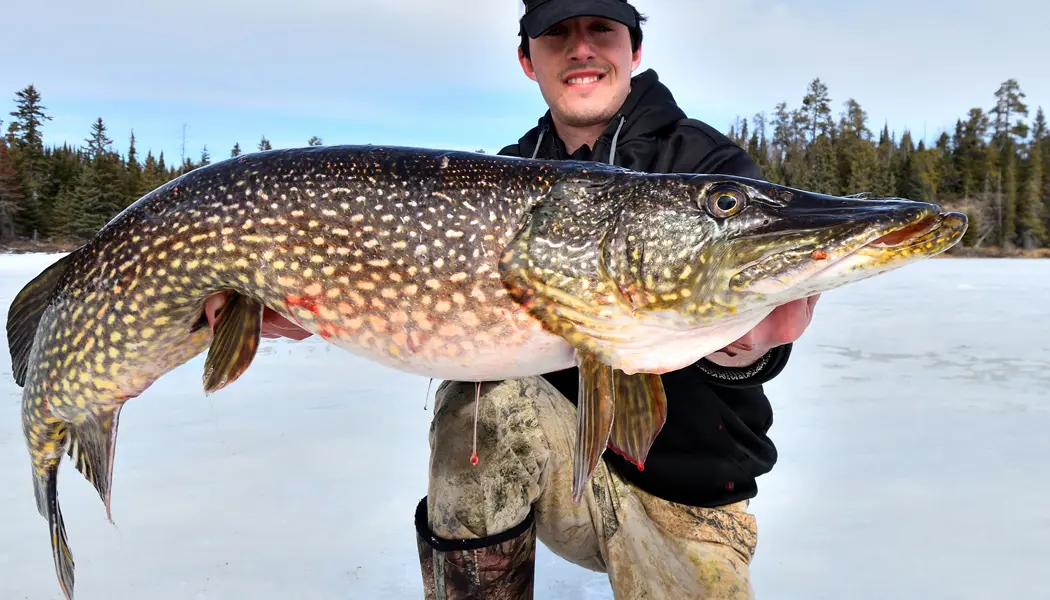
The best way to begin ice fishing is by targeting a species or group of fish that are prolific and relatively easy to catch, such as panfish—yellow perch, black crappies and bluegills.
Many Ontario ice anglers remain lifelong panfish aficionados, while others graduate to bigger and more challenging walleye, whitefish, brook trout, rainbow trout, lake trout and trophy-size northern pike.
Black crappie
Ontario offers the best black crappie ice fishing in the world.
From Rainy Lake, Lake of the Woods and Wabigoon Lake in Sunset Country and the waters along the north shore of Georgian Bay and Lake Huron between Sault Ste. Marie and Blind River to southern Ontario’s famed Kawartha Lakes.
Having a good sonar unit will help with crappie ice fishing, as the fish tend to hide themselves inside the weeds during the day. But when the sun gets low, they slide out into the open areas and are easy to catch using tiny ice jigs tipped with small soft plastic grubs.
Anglers can use two rods and holes in Ontario, so ice fishers will cut a pair side-by-side only a foot apart and vertically jig a flashy spoon in one hole to attract and trigger any curious crappies. If they don’t take the bait, they will devour the tiny jig, tipped with a small soft plastic larvae suspended in the nearby second hole.
Yellow perch
Lake Simcoe has earned the reputation as the world’s finest yellow perch ice fishery—but the winter perch anglers also fish in Black Bay on Lake Superior, on Lake Nipissing, Rainy Lake, Lac des Milles Lac and Lake of the Woods.
In truth, Ontario may offer better winter yellow perch opportunities than any other species. And they’re often over 33 centimetres long (13 inches), giving new meaning to the term “jumbo perch”.
Yellow, black and orange panfish go crazy when they see a bright shiny spoon or tungsten ice jig tipped with a wax worm, maggot or pinched head of a salted shiner. Just lift your lure, pause and then let it flutter back down to the bottom. And hold on tightly to your rod.
Brook and rainbow trout
Ontario offers exceptional ice fishing opportunities for brook (speckled) trout, rainbow trout and splake in more than 2,000 of the most scenic bodies of water—from Sunset Country in the Northwest through the famous Superior, Nipigon, Algoma and Temagami regions, and all the way down into Muskoka, Haliburton Highlands and Algonquin Park home to the most southerly, naturally sustaining population of brook trout on earth.
And because so many of the lakes are small and medium-sized, they freeze up first, allowing you to be ice fishing early in the season.
Lake trout
Ontario has more lakes to catch trout than anywhere else in the world.
A few of Ontario’s most famous lake trout lakes include Lake of the Woods, Clearwater Lake, Minnitaki Lake, Lake Superior, Lake Nipigon, Lake Temagami, Lake Muskoka and Lake Simcoe.
A favoured spot to set up for the heavyweight giants of winter is at the end of an underwater point that juts out from shore or from an island. High rock walls and sheer granite cliffs are two other winter hot spots. The features obstruct and confuse silvery baitfish, such as ciscoes, smelts and shiners. Drop your lure into the frenzied activity—as the lake trout shoot up from their ambush locations, they’re sure to mistake it for a wounded baitfish.
Walleye
If you tire of catching lake trout, consider going after walleye in the afternoon as the sun approaches the horizon.
Walleye have amongst the biggest and most reflective eyes of any animal in relation to their body size. And they are negatively phototactic, meaning they can see better in dark shadows, dimly lit surroundings and even at night, than in bright sunny settings.
Therefore, the first hour of daylight in the morning and the last hour in the afternoon are the two best times of the day to catch what many consider the finest-tasting freshwater fish. Or you can simply follow the shade line around the structure you’re fishing.
These giants like to prey upon small yellow perch, so ice anglers favour 1/8- to 3/8-ounce jigs, spoons and Jigging Rap-style baits that are painted bright yellow, orange and chartreuse. In other words, yellow perch look-alikes.
There are thousands of popular Ontario winter walleye waters. Still, Rainy Lake, Lac Seul, Eagle Lake, Mille Lacs Lake, Lake Abitibi, Lake Nipissing, Georgian Bay, Lake Muskoka and the Bay of Quinte all have their devotees.
Northern pike
Northern pike can grow to monstrous proportions in Ontario, especially in the lakes across the vast north of the province on the Canadian Shield.
While anglers travel from around the world in the open water season to catch the pike of a lifetime in Ontario, it is even more fun in the winter. The big fish waters like Rainy Lake, Winnipeg River, Eagle Lake, Lac Seul, Lac de Milles Lacs, Lake Nipissing, Georgian Bay, Lake Abitibi, Lake Temiskaming and Lake Simcoe are renown for good reason, but many of the biggest pike are caught every winter in lesser-known lakes.
One of the best Ontario winter pike fishing tricks is jigging a large lipless crankbait in the latter half of the ice fishing season (March and April). Spool your rod with a premium 20-pound test braided line with a titanium leader. The pike strikes are so savage that they have been known to snap ice rods in half and knock anglers off their feet.
Whitefish
Whitefish grow big, too, especially in Lake Simcoe, regarded as the finest winter whitefish fishery on earth for over a century.
Although whitefish anglers on Georgian Bay, Lake Muskoka, Lake Nipissing, Lake Temagami and the many bays along the north shore of Lake Superior, between Thunder Bay and Sault Ste. Marie will argue their favourite haunt is equally supreme.
Historically, winter whitefish anglers have used tip-ups and spreader rigs to catch whitefish. More recently, nose-heavy Meegs-style jigs have stolen the scene and revolutionized the way winter anglers target the species. Zoom in on your sonar screen to highlight the bottom of the lake, where whitefish feed by sucking in silt, filtering out crustaceans and insect larvae and spewing out the leftovers. When you stir up the sediments by tapping your jig into the mud, nearby whitefish will swoop in to investigate, believing it is another feeding whitefish.
Preparing for your trip
Necessary paperwork and attire are essential to prepare for an ice fishing experience.
Fishing licence
Before heading out to ice fish, Canadian residents between 18 and 65 years of age need an Outdoors Card and a fishing licence. There are two types of licences—sport and conservation. You can purchase a fishing licence online for one day, eight days, one year or three years.
Non-residents over 18 years of age are also required to purchase an Outdoors Card and a fishing licence for one or three years. Non-residents under 18, accompanied by a person with a valid Outdoors Card and Fishing Licence, do not need either document.
Fishing regulations
According to the Ministry of Natural Resources (MNR) Fishing Regulations, all fish kept (and not released) are part of the catch and possession limit of the person holding the licence. For anglers under 18 to gain their own fish limit, they will need the Outdoors Card and Fishing Licence.
Review the Ontario Fishing Regulations Summary for restrictions on fish limits, size, catch and release and the open and close seasons for fish species.
Learn more about fishing in Ontario, including urban angling, Crown Land fishing, zone maps, sustainable fishing and what fish are safe to eat.
What to wear for ice fishing
Pack appropriate clothing. Cold weather is an intrinsic part of ice fishing, so dressing for the occasion is imperative; layers are best.
Consider the following:
- The layer closest to the skin is important. Start with a base layer of quick-dry dry breathable underwear that wicks away moisture.
- Add additional layers of wool and/or fleece, followed by windproof insulated pants and jacket.
- Gloves make it much easier to perform many of the tasks associated with ice fishing, but mitts are much warmer. Bring both and switch between the two as required.
- A warm and windproof hat that covers the ears or is equipped with ear flaps is essential for windy, cold conditions. A spare lighter knit hat is good to have when it’s mild.
- Footwear is another important consideration. You’ll want warm winter boots rated to -100°C for dry or snowy conditions. In wet conditions, insulated boots that are completely waterproof are essential for staying comfortable and dry.
- Sunny conditions call for sunglasses and sunscreen applied to any exposed skin.
Ice fishing gear and equipment
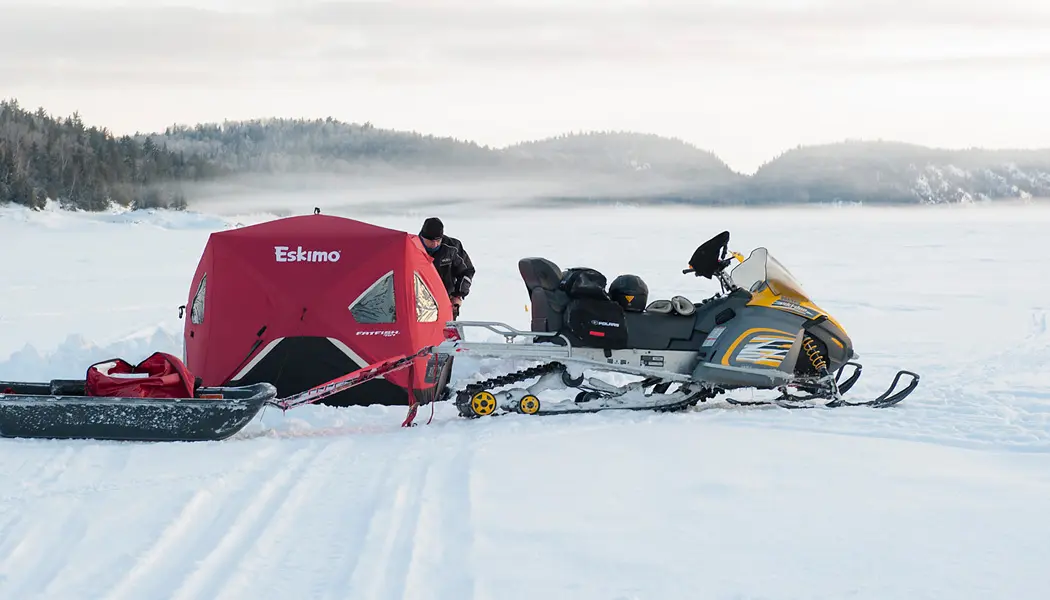
Ice fishing lodges, guides and outfitters will often supply the basics for your ice fishing excursion. Before your trip, ask what gear is supplied and what you need to bring.
Fishing rods and reels
You can ice fish with the rods and reels you use in the summertime, but you will have more fun—and catch more fish—using an ice rod made for the purpose. As they’re not designed for casting, ice fishing rods are generally shorter. The best fishing rods for ice fishing are usually only 60 to 121 centimetres (24 to 48 inches) long, much shorter than the rods used in the rest of the year. Ask your host what is best based on the species available.
When ice fishing for panfish like yellow perch, black crappies, bluegills and herring, focus on 24- to 36-inch (60- to 91-centimetre) medium-light and light action rods. As a general rule, smaller 1000 series spinning reels spooled with three-, four-, and five-pound test monofilament and fluorocarbon line pair up perfectly with the panfish rods.
For walleye and medium-size trout and pike, medium-light, medium and medium-heavy action ice rods are ideal choices. The medium-light stick is handy as a set rod: you can lay it across the top of a bucket so that the noodle-like tip bends effortlessly to signal bites.
2000 series reels equipped with six- and eight-pound line—even 10-pound, if a big fish is a possibility—are the gold standard strengths for medium-size walleye, northern pike and trout.
Finally, when targeting giant Ontario lake trout and huge northern pike, slightly longer 38- to 42-inch (96- to 106-centimetre) medium-heavy and heavy action ice rods will let you handle the array of bigger baits you need to use to conquer the Goliaths. But you will want a 3000 series reel loaded with 10- to 15-pound test to handle the big line peeling pike and lake trout. Don’t use a wire leader that takes away the action from your lure unless you’re specifically targeting pike.
Anglers are permitted to ice fish in Ontario using two holes, so double your chances with an extra rod or two.
Lines and lures
If you’re ice fishing for panfish, be sure to have at hand a selection of 1/8- to 1/32-ounce tungsten jigs like the VMC Tungsten Fly and H.T. Marmooska, which you can tip with a pinhead minnow, wax worm or maggot. Tiny spoons like the smallest Williams Wabler and Jigging Rap-style baits will fill up the quiver.
For Ontario’s ever-popular winter walleye, northern pike and trout, it will suffice to use a number five or number seven Jigging Rap-style lure all winter long. But medium-size spoons like the Williams Bully and lipless crankbaits like the Kamooki Smartfish have proven their worth, so keep one or two handy at all times.
Ice anglers have caught more lake trout using quarter to half-ounce white and silver tube jigs than any other bait, so they’re the best lure to start out with. If you like experimenting, round out your trout and big toothy critter tackle box with bigger lipless crankbaits, jigging spoons and soft plastic swim baits.
Fish finders and underwater cameras
While electronic devices to help locate fish have long been used in open water fishing, they’re relatively new on the ice fishing scene.
Devices known as flashers use coloured lights to mark the lake bottom, bait or lure and any fish that might be in the water column. In addition, there are a variety of liquid crystal display (LCD) screen fish finders that are constantly improving in terms of performance in sub-zero temperatures.
A basic function of a fish finder is to show water depth. In winter, they help locate structures like reefs, rock piles and drop-offs that can attract fish. Some models are equipped with GPS technology to mark likely spots for future reference. They also show fish position in the water column and in some cases, where a lure is in relation to the fish, so you can reel up to the appropriate level and tease fish into striking.
One of the more recent developments in fish finders is a transducer positioned under the ice on a shaft that can be rotated 360° to show fish locations within a 40-metre radius or more. Getting a lure in front of those fish is as easy as drilling a hole over their indicated position.
Underwater cameras are another popular device. Lower a small camera by a long cable to the bottom for a video feed of what’s happening in the depths. This allows you to identify the species and how they react to a variety of baits and lures.
Basics of ice fishing
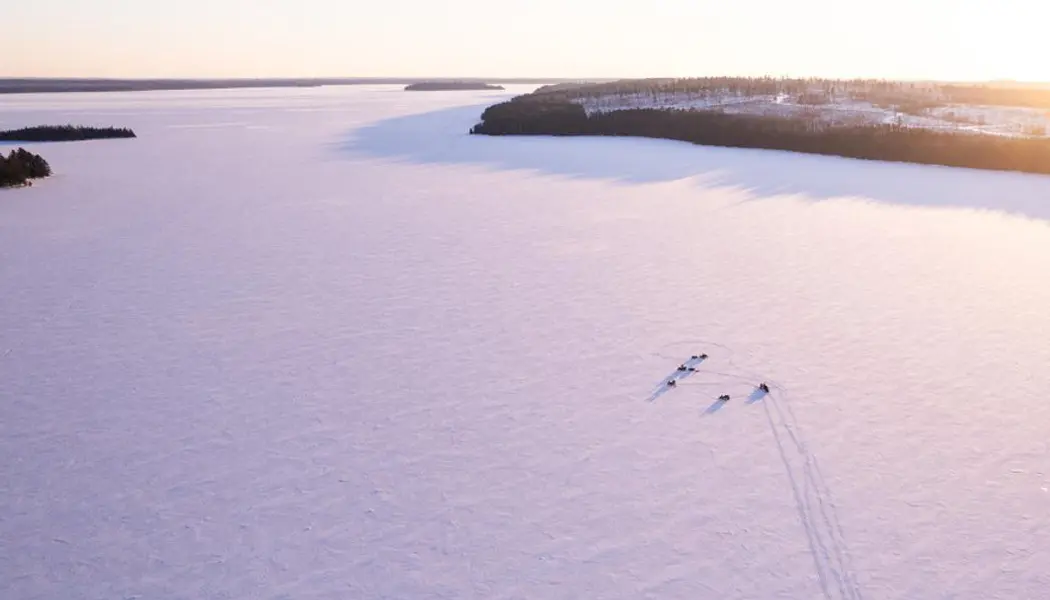
Safety is the top priority when planning an ice fishing trip. Be informed about ice conditions and learn how to stay safe on the ice.
Ice safety
As a general guide, approximately 10 centimetres (4 inches) of solid ice will hold a person, 12.5 to 18 centimetres (5 to 7 inches) is strong enough for a snowmobile, 20 to 30 centimetres (8 to 12 inches) a car and 30 to 38 centimetres (12 to 15 inches) to support a pickup truck.
Ice thickness can vary.
Avoid areas of current around river mouths or narrows where ice can be significantly thinner, especially early in the season when the ice is just forming and late in the season when the ice starts to deteriorate.
Ice quality can also vary.
Every water system is different; err on the side of caution and tap into local knowledge at bait shops or sporting goods stores if you are unfamiliar with the area.
Ice fishing shelters
Many ice fishing lodges and outfitters provide ice huts as part of the experience, but some anglers prefer to bring their own ice fishing shelters.
Insulated, portable ice fishing shelters have helped revolutionize the sport, transforming even the coldest winter days into warm and comfortable experiences.
A compact hub-style shelter can be assembled and disassembled in minutes, and then folded and stored in a convenient carry bag. Hub-style shelters vary in size, accommodating up to six ice anglers with spacious interiors.
Flip-over-style shelters, on the other hand, attach to the back of a snowmobile or ATV. They offer fixed padded seats and aluminum rods that extend out and flip over.
If you already have a snowmobile or an ATV, flip-over shelters are the ultimate way to ice fish in comfort.
Drilling the ice hole
Many lodges and resorts have predrilled holes and will offer transportation to the hole.
If you need to drill your own hole, there can be as much as a full metre (three feet) or more of ice between you and the water. The most common way to create an ice hole is with an ice auger, a large spiral shaft tipped with an ice drill and angled blades.
The most popular sizes of ice augers make holes with diameters of 15, 20 and 25 centimetres (6, 8 and 10 inches). A sharp hand-powered ice auger will also do the job; however, power augers save time and energy. A wide range of options includes two-stroke or four-stroke gas and propane-powered augers, as well as electric augers powered by a rechargeable battery. As with all battery-powered units, keep batteries warm and have a spare.
Getting around on the ice
Walking on foot, snowshoeing or skiing are easy ways to access the ice. A backpack or sled can be used to carry bait, food and gear for a day on the ice.
Snowmobiles are the most popular means of travelling long distances over snowy landscapes. Those designed with ice fishing in mind generally have long and wide tracks for maximum flotation in deep snow and to haul sleds.
Anglers also use all-terrain vehicles (ATVs) year-round, especially in areas that don’t receive heavy snow. Like snowmobiles, ATVs can haul sleds full of gear. They can also be fitted with tracks, which broaden horizons when the snow is deep. When travelling by snowmobile or ATV, stay on established trails, as there’s always the possibility of slush.
On many larger northern Ontario lakes, ice roads are plowed, and ice fishing spots are accessed by cars and trucks.
Experience some of the best freshwater ice fishing in the world with the help of local guides, lodges and outfitters in Ontario, Canada.
Related content
Last updated: December 8, 2025


